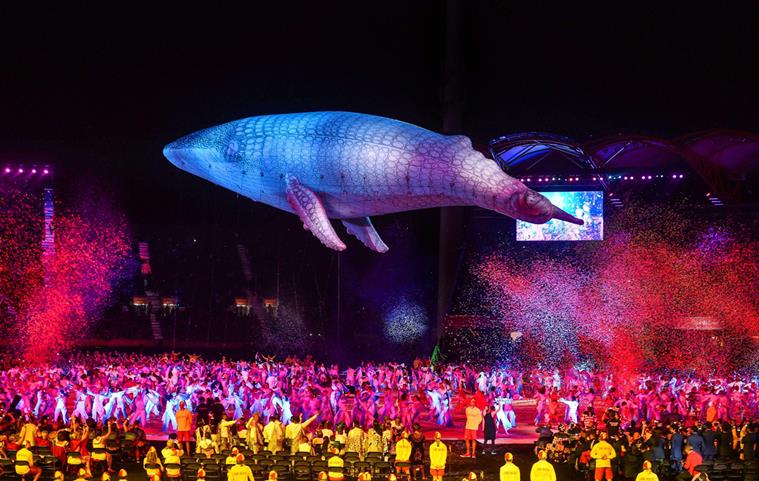 Australia’s most famous humpback white whale, spotted in the warm waters of North Queensland, hovered over the Metricon Stadium that was wrapped in a kaleidoscope of colours. (Source: PTI)
Australia’s most famous humpback white whale, spotted in the warm waters of North Queensland, hovered over the Metricon Stadium that was wrapped in a kaleidoscope of colours. (Source: PTI)
They couldn’t host the ceremony at the beach. So they got the beach to the ceremony.
The surfers glided on their boards. Nippers led the teams out while a lifeguard called them in. There were bikinis and budgie smugglers, the white silica sand and the crystal blue water. And then, right at the end, there was Migaloo.
Australia’s most famous humpback white whale, spotted in the warm waters of North Queensland, hovered over the Metricon Stadium that was wrapped in a kaleidoscope of colours. It reminded you of the flying tram at the MCG in 2006 and the giant helium balloon at Delhi 2010. That, and the customary pyrotechnic, was the only similarity between this and the previous opening ceremonies.
This wasn’t a couple of hours of Australiana like it was at the opening ceremony Sydney Olympics. Rather, this was Gold Coast indulging in some unabashed showing off. And you really couldn’t grudge them for that. The city’s 52km of golden beaches is the reason why the Southerners brave the gridlock of the M1 during the winters.
The ceremony had all of it in all its glory. They welcomed the 4,600 athletes from 71 nations with a ‘Jingeri’, not a G’day. The only thing missing to complete the theme was the thong — not the innerwear but the flip-flop that are commonly spotted at the beachfronts.
READ | ‘Jingeri’ or ‘G-days’ for CWG days? Choice of greeting sparks a debate
But if the beaches were flavour of the ceremony, Australia’s aboriginal culture was at the heart of it. For all its glitz, Gold Coast — rather, Queensland — is battling a perception problem for the last four decades because of its policies towards the aboriginal people, who feel marginalized in the state.
Last year, there were reports of a discovery of a rock that lent scientific evidence to claims that the Indigenous people were the occupants of Burleigh Heads 65,000 years ago, much before the Gold Coast suburb became famous for its waves.
Context to the game
That the opening ceremony began with that, provided context to the Games. This was about giving the Aboriginal population recognition they’ve been demanding for years – including the protests outside the stadium minutes leading into the ceremony. The 35,000-odd spectators were further transported back 335 million years ago, showcasing the super-continent of Pangaea with some stunning usage of CGA.
The use of CGA made the ceremony feel like an Imax flick. Amidst the shades of orange and blue, Australia’s most famous didgeridoo player William Barton brought everyone back to the more modern Gold Coast, with its beaches and glistening skyscrapers.
It perfectly set the tone for the athletes’ arrival. Scotland, the hosts of the previous CWG, led the teams out as the live orchestra ensured the longest section of the ceremony wouldn’t end up getting boring for the spectators, as it often does.
The Indians walked out to scattered cheers from the stands. They were led by PV Sindhu, who had pulled so far ahead of the rest of the Indian contingent that Usain Bolt would’ve been proud of her. Even the nipper, with a surfboard tucked under his shoulders, accompanying her had a tough time to match her speed.
Over the next 10 days, India will need a surfboard themselves to coast over the wave of controversies that have surrounded them since their arrival in Gold Coast last week. Most boxers and shuttlers (read Saina), the two bunch at the centre of it all, did not turn up because of the early starts on Thursday.
This is the first poke of a multi-discipline event for several Indian athletes. It’s a fairly young squad, signaling a transition of sorts in several sports. What colour medal they win might not really be a pointer towards their readiness to compete at the Olympics. But their performance certainly will. In most events, India will end up facing the Australians, who are likely to win a bunch of medals as always.
England did finish on top of the medal’s tally at the Glasgow CWG in 2014. But that was a trickle-down effect of the heavy investment into Olympic sports in the lead-up to London Olympics, just like India’s medal tally at the 2012 Games spiked on the back of hosting the CWG two years prior to it.
Normal service is likely to be restored here, with a bulk of Australia’s 424 athletes expected to go home with medals. Mark Knowles, Australia’s new face for fairplay, is expected to lead the hockey team to yet another gold. He was chosen the flag-bearer ahead of star sprinter Sally Pearson, who was given the bigger responsibility at the baton relay at Surfers Paradise, the beach that was masterfully recreated inside the stadium.
The beach would’ve been the ceremony’s hero. But without Knowles and Pearson — Queensland’s biggest sports stars — the evening would’ve been rather incomplete.